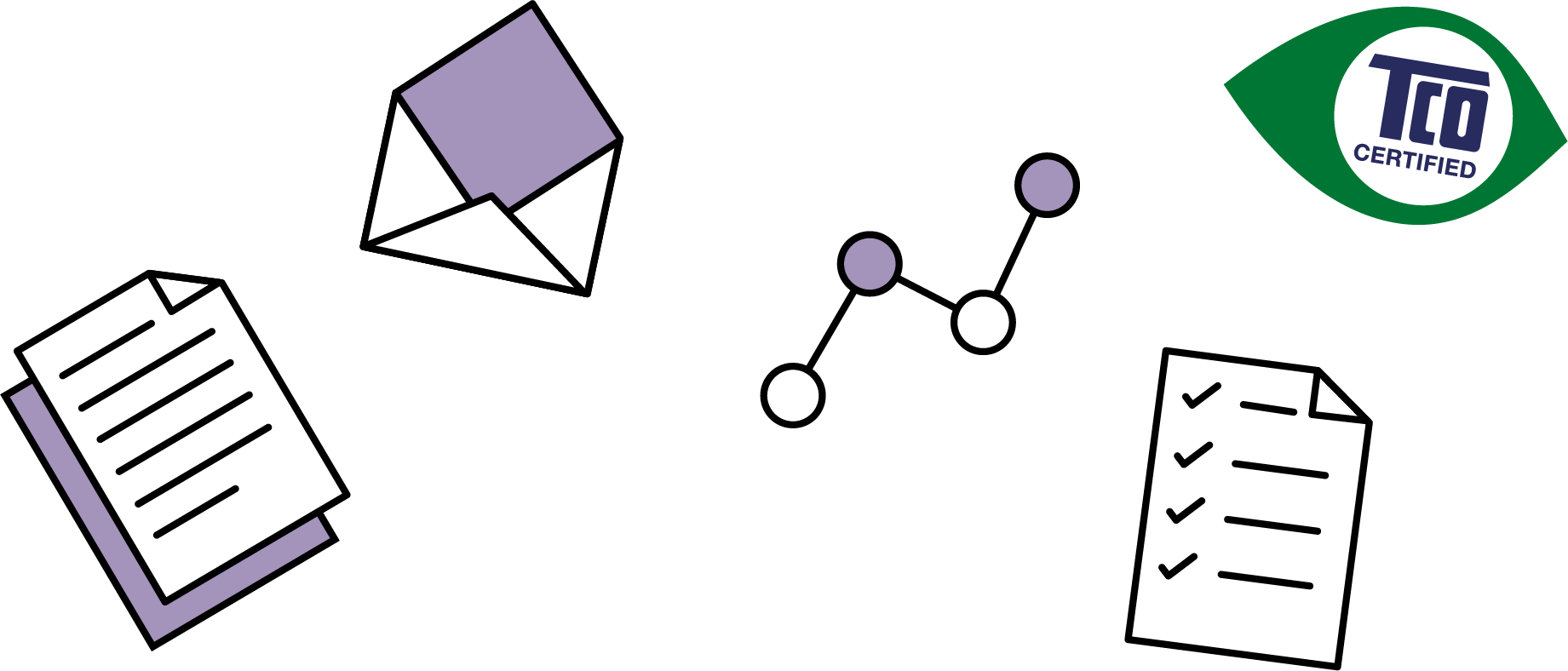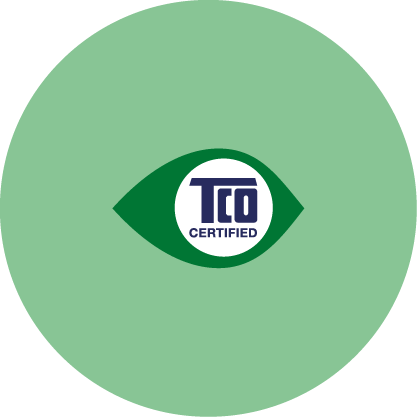
How to use TCO Certified in IT procurement
Including TCO Certified in procurement processes is an easy, independently verified way to choose a more sustainable product and reduce your IT system’s environmental and social footprint. Our step-by-step guide helps you get started and offers practical tips along the way.
THE EASY WAY
Require TCO Certified in technical specifications
Using TCO Certified in procurement is as easy as citing it by name in your technical specifications when procuring IT hardware. Doing so means you don’t need extensive sustainability knowledge or access to factories worldwide. We set relevant criteria and verify compliance of products and supply chains, saving you valuable time and resources. When asking for TCO Certified, you’re not only making an informed choice you can trust. Together with other purchasers, you’re also supporting the same system and sending a powerful global signal to the IT industry that sustainability is important.
Recommended language for citing TCO Certified
Technical specifications
“Products are certified according to TCO Certified.”
Accepted verification/proof of compliance
“Upon delivery and throughout the whole contract period, products are actively listed as certified according to TCO Certified in Product Finder, available at tcocertified.com/product-finder.”.
More tailored examples of how to require TCO Certified for specific procurement scenarios are available below.
THE COMPREHENSIVE WAY
Make TCO Certified part of your sustainable IT strategy
Simply requiring products certified according to TCO Certified in your procurement technical specifications helps you make responsible choices, reduce risk, and meet regulatory obligations. By taking a more comprehensive and strategic approach, you can get several other benefits. This involves preparing the organization, implementing the procurement, and effectively realizing the contract to ensure responsible choices while achieving sustainability goals. Integrating TCO Certified into your sustainable IT strategy enables you to effectively report on sustainability and monitor the impacts of the products you purchase and use in four key areas: climate, substances, circularity, and supply chain.

1. Prepare your organization
Engage colleagues and management
It’s essential to understand the sustainability impacts of IT products throughout the lifecycle and the benefits of requiring certified products. Using TCO Certified allows you to bundle your procurement power with other organizations worldwide and demand a reduction in climate impact, improvements in supply chain conditions, and a circular future for IT. Ensuring colleagues and management are aligned on the importance of buying certified IT products makes it easier to establish sustainability as a priority in your organization’s procurement policies.
Talk to your suppliers early and often
Discussing your sustainability priorities and your intention to specify TCO Certified with your suppliers early in the procurement planning phase will help them align with your requirements and deliver the certified models you want. Using Product Finder to gather information from suppliers about the certification status of their product portfolio can help start the dialogue.
Check your IT product portfolio
You can easily check the certification status of your current IT product portfolio by using our tool, Product Finder, which lists all certified product models. You’ll find thousands of certified IT products from well-known brands — perhaps even some of the products you’re already using. However, it’s important to note that even if you’re currently using certified products, you need to specify TCO Certified in your next IT procurement to show that sustainability is a priority for your organization.


2. Include TCO Certified in IT procurement
Purchaser demand incentivizes IT brands to apply for TCO Certified. Therefore, including TCO Certified in procurement is a powerful driver of industry progress and ensures the availability of certified products. Depending on your type of organization and the rules you must follow, you can require TCO Certified in your procurement processes differently.
Recommended language for citing TCO Certified
Technical specifications
“Products are certified according to TCO Certified.”
Accepted verification/proof of compliance
“Upon delivery and throughout the whole contract period, products are actively listed as certified according to TCO Certified in Product Finder, available at tcocertified.com/product-finder.”
Use TCO Certified in specific procurement scenarios
Some procurement scenarios mean citing TCO Certified in a more specific way, such as allowing for use on a voluntary basis, accepting equivalent proof of compliance or specifying a generation number. You find recommended language for specific scenarios below. For all these alternatives, enter “Upon delivery and throughout the whole contract period, products are actively listed as certified according to TCO Certified in Product Finder, available at tcocertified.com/product-finder.” as accepted verification/proof of compliance.
Allowing on a voluntary basis
If you need to include TCO Certified on a voluntary basis, you can specify the following as an award or assessment criterion:
“Offers, including products certified according to TCO Certified, will be awarded.”
Remember to include the awarding of extra points or weighting.
Accepting equivalent proof of compliance
If you need to allow for equivalent proof of compliance, you can specify the following in the technical specifications:
“Products must be certified according to TCO Certified or equivalent.”
As equivalent proof, you need a signed ‘Declaration of Equivalence’ by an independent organization accredited to ISO 17025 and ISO 17021, demonstrating compliance with the criteria in TCO Certified.
Naming a specific generation number
If you need to refer to a specific generation number, you could specify the following in the technical specifications:
“Products are certified according to TCO Certified, generation 9, or higher”.
Remember that a new generation of TCO Certified is released every three years. You need to update your procurement documents regularly with a relevant generation number.
Asking for products that are not yet certified
Use the recommendations above also when you want to procure product models that are not yet certified according to TCO Certified. Making your intentions clear to suppliers is an efficient way of pushing the IT industry in a sustainable direction. Inform your suppliers of your intention to specify TCO Certified at least six months before your request for proposal. This way, relevant IT brands have enough time to undergo all the product tests, assessments and audits needed to get products certified according to TCO Certified.


3. Get all the benefits of TCO Certified
Stay up-to-date with Product Finder
Ensure that purchasers in your organization understand why TCO Certified is specified in procurement and that they should prioritize certified products. Use our tool, Product Finder, to stay updated on certified models and certificate validity dates. You can select the product category you are interested in or search for a specific IT brand or model. Product Finder’s “watcher function” allows you to set up a customized, real-time tracking feature that delivers regular updates on product certification status.
Hold suppliers accountable
Follow up regularly with your suppliers to ensure they provide you with certified products upon delivery and throughout the duration of the contract. This is especially important when product models are periodically refreshed. An active certificate means that the TCO Certified system continues to monitor product and factory compliance, saving you time and resources. Check the certification status of your IT product portfolio in our Product Finder.
Track your progress with Report Generator
With Report Generator, you can create customized sustainability reports for the certified IT products your organization buys and uses. The reports include independently verified data and claims to support your sustainability strategy, reporting and communications.
Data and claims cover:
- Climate: product carbon footprint and scope 2 & 3 emissions.
- Substances: hazardous substances and safer substitutions.
- Circularity: material footprint, extended product life, and e-waste.
- Supply chain: social and environmental responsibility in the supply chain.
